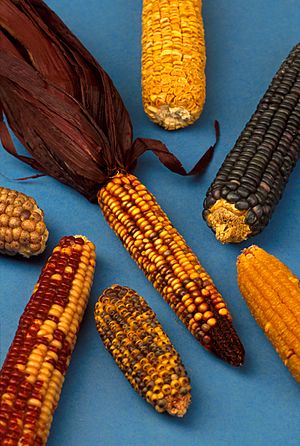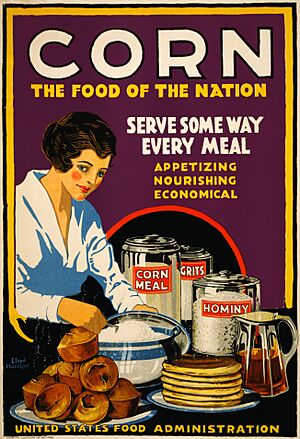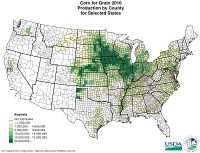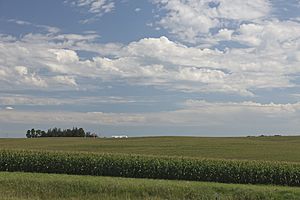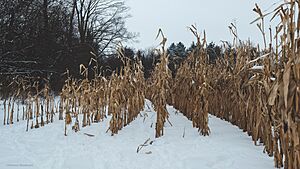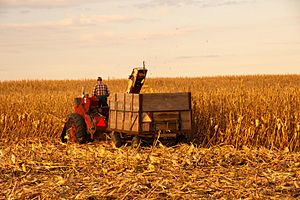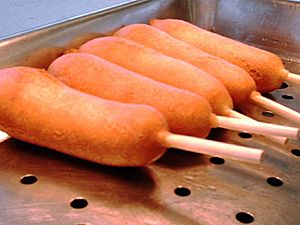Corn production in the United States facts for kids
Corn, also known as "maize" (Zea mays mays), is a super important crop for the United States economy. The U.S. grows more corn than any other country in the world. About 96 million acres of land are used to grow corn here. Most of this corn grows in places like west/north central Iowa and east central Illinois. The U.S. exports, or sends to other countries, about 13% of the corn it grows each year.
Contents
How Corn Started
Corn began spreading across North America thousands of years ago. The very first corn plant, called teosinte, still grows in Mexico today. Over time, people used plant breeding to make newer types of corn much bigger and better. This was first done by Native Americans and later by scientists. Now, corn is the third most important grain crop in the world.
Roxanne Dunbar-Ortiz, in her book An Indigenous Peoples' History of the United States, says that farming by Native Americans was built around corn. She explains that corn was only developed in the Americas before Columbus arrived. This makes its creation a special invention by early American farmers.
In the book Tribes That Slumber, Thomas Lewis and Madeline Kneberg wrote that corn was "the staff of life" for the Cherokee people. This means it was their main food. The Cherokee grew three kinds of corn:
- "Flour corn" had large, white kernels.
- "Six weeks corn" was like popcorn and was roasted when it was young.
- "Hominy corn" had smooth, hard kernels that could be white, blue, red, yellow, or mixed colors.
By 1804, when Meriwether Lewis studied where corn could best grow in the U.S., settlers had already planted it widely. This was because corn could grow well in different climates and soils. Once Lewis and Clark confirmed that the central U.S., known as the Midwestern United States, was great for corn, many settlers moved there. They started growing huge amounts of corn.
Over hundreds of years, corn plants changed to give bigger harvests. Farming methods also got better. Because of this, the fertile central area became known as the "Corn Belt". Farmers started using special "hybrid" corn from the late 1880s. This hybrid corn was created by university research using cross-breeding. This new way of farming changed everything. In 1934, only 1% of corn farms used hybrid varieties. By the 1940s, this jumped to 78% and kept growing.
In the 1950s, Henry A. Wallace, who was once Vice President and Secretary of Agriculture, said that the Corn Belt had become the most productive farming area the world had ever seen. This trend continues today. American farms now produce 20% more corn per acre than farms in other parts of the world.
Corn farming has grown so much that it's now a big business in 14 states. To help corn farmers, the Corn Farmers Coalition was formed. This group brings together the National Corn Growers Association and 14 state corn groups.
How Much Corn is Grown?
The United States Department of Agriculture (USDA) reported that in 2021, the average U.S. corn yield was 177 bushels per acre. This was a record high! Sixteen states also set new records for corn output. Iowa, for example, reported a record of 205 bushels of corn per acre. In total, the U.S. produced 15.1 billion bushels of corn in 2021.
In 2019, the U.S. produced about 13.016 billion bushels of corn. A big part of this corn, about 37%, is used to make ethanol and a product called DDGS. This adds up to 4,845 million bushels. The table below shows other ways corn is used.
| Uses of Corn/Maize | ||||
|---|---|---|---|---|
| Type | Amount (Million Bushels) | Percentage | ||
| Livestock Feed | 4345 | 33 | ||
| Beef cattle | 1213 | 9 | ||
| Poultry | 1205 | 9 | ||
| Hogs | 1004 | 8 | ||
| Dairy | 823 | 6 | ||
| Other animals | 100 | 1 | ||
| Ethanol | 3552 | 27 | ||
| Exports | 1450 | 11 | ||
| Other processing* | 1420 | 11 | ||
| DDGS | 1293 | 10 | ||
| Residual Use | 1055 | 8 | ||
| Total | 13016 | 100 | ||
| Million Bushels & Percentage. | ||||
- 'Other processing' includes making High Fructose Corn Syrup, sweeteners, starch, alcohol for drinks, and cereals.
From 1950 to 1959, the U.S. produced about three billion bushels of corn each year. In recent years, this has jumped to about nine billion bushels annually. Most corn is grown in west north central Iowa and east central Illinois. In 2018, the national average was 176 bushels per acre. Farmers are getting better at growing corn. In a 2011 contest, farmers averaged 300 bushels per acre! Experts believe that by 2030, farms could produce 300 bushels per acre from the same amount of land.
Corn and Ethanol Fuel
Ethanol can be made from corn and other plants like sugar cane. After making ethanol, a leftover product called DDGS is created. This DDGS is about 33% of the original corn and is used to feed livestock. Ethanol is mixed with gasoline to make fuels like E10 and E85 for cars. Adding ethanol to gasoline helps reduce harmful gases released into the air by about 34%. One bushel of corn can make 2.8 gallons of ethanol and 17-18 pounds of DDGS.
Because there's a high demand for ethanol, corn prices have gone up. This has led farmers to grow more corn. They often switch between growing corn and soybeans. This means less land is used for soybeans. A law passed in 1996 also allowed more land to be used for corn.
Corn Farming in the U.S.
About 80 million acres of land in the United States are used only for growing corn. The U.S. is the world's top corn producer. In 2009, it produced over 333 million tons of corn.
There are about 316,000 corn farms in the U.S. A huge number, about 95% of them, are family-owned. Also, more than 30% of corn farms are run by women.
The highest corn yields were recorded around 2011, with 12.4 billion bushels harvested. The average yield was more than 140 bushels per acre. Only about 11% of corn farms use irrigation (watering systems). The rest rely on rain. Farmers have also started using methods that help protect the soil. These efforts have reduced soil erosion by 44%.
Why Corn Gets Subsidies
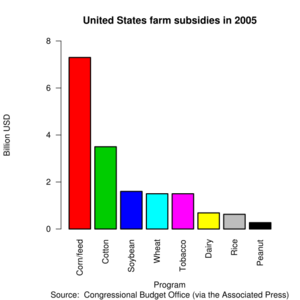
The U.S. government has helped corn farmers with money, called subsidies, since the 1930s. This started when there was too much food after a war in Europe, and corn prices dropped very low. In the 1980s, these subsidies grew a lot.
From 1995 to 2014, U.S. corn subsidies averaged about 4.7 billion dollars each year. It was predicted that the U.S. would spend about $97.29 billion per year on farm and food programs over the next ten years.
Some people have criticized these subsidies for a few reasons:
- They can be very expensive for taxpayers, and the cost can change a lot.
- They might discourage farmers from growing different crops or planning for bad weather.
- They might make it harder for small farmers in other countries to sell their corn. This is because U.S. corn can be sold very cheaply due to the subsidies.
The Value of Corn
On average, Americans spend about $267 each year buying corn products. In 2015, one bushel of corn cost about $3.50. The value of corn can change depending on where it's grown, how much is produced, and its quality. Things like weather or economic problems can also make corn prices go up or down. The value of corn is generally increasing because the country needs and uses more of it.
Corn Production by State
- Iowa
Iowa grows the most corn in the U.S. It produces three times more corn than Mexico! In 2007, Iowa harvested 3,548 acres of sweet corn. In 2011, the state had 92,300 corn farms on 30.7 million acres. The average farm size was 333 acres, and the average value of land per acre was $6,708. That same year, Iowa harvested 13.7 million acres of corn for grain, producing 2.36 billion bushels. This yielded 172.0 bushels per acre, with a total value of $14.5 billion. In 2012, Iowa grew almost 1.88 billion bushels of corn on 13.7 million acres. For 2013, it was predicted to grow 2.45 billion bushels on 13.97 million acres.
- Nebraska
Nebraska is often called the "Cornhusker State." It's the third-largest corn-producing state in the United States.
- Minnesota
Corn is the biggest crop in Minnesota. From 1922–1931, the average production was 30.4 bushels per acre. This grew to 46.6 bushels per acre from 1947–1956, then 91.4 bushels per acre in 1973, and 142 bushels per acre in 1994. Between 1935 and 1946, farmers started using hybrid corn varieties more often. In 2010, Minnesota produced 1.29 billion bushels. In 2012, Minnesota farmers grew their largest corn crop ever, with 1.37 billion bushels harvested. This equaled 165 bushels per acre on 250,000 acres.
- Illinois
The first corn types grown in Illinois came from local Native American groups or from the New England states. After the American Civil War, new types of corn were developed that grew well in Illinois's soil and climate, like Reid's Yellow Dent. From 1900–1905, 10.5 million acres were planted with corn. This dropped to 8.862 million acres from 1925–1930. In 2012, Illinois planted 12.8 million acres of corn. It ranked fourth in corn production, after Iowa, Minnesota, and Nebraska. The state averaged 105 bushels per acre in 2012, which was less than the 157 bushels per acre in 2010 and 2011.
- Alaska
Even though Alaska has a cold climate, some farmers there still manage to grow corn. They often use methods like greenhouse farming. Corn is quite popular among people in Alaska.
- Indiana
Corn is a popular crop in Indiana. Most of the corn grown there is used to feed animals. Indiana is located in the United States' Corn Belt.
- Texas
The state of Texas is a big producer of corn. In 2010, the final estimate for corn produced was about 301 million bushels on 2.3 million acres of land. This corn was worth a total of $1.2 billion.
- Alabama
Corn was brought to Alabama around the 1700s. Traces of corn have been found in Nuyuka's Upper Creek village that date back to that time.



